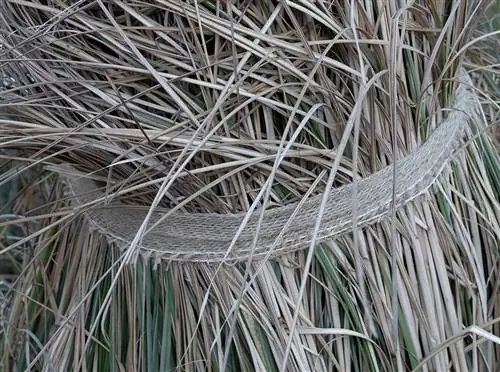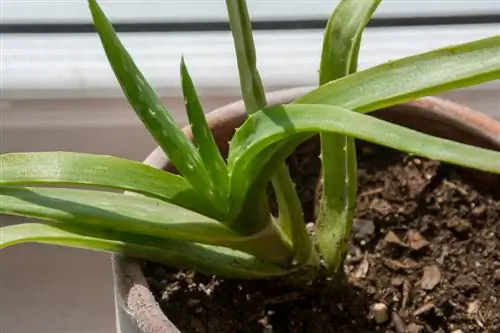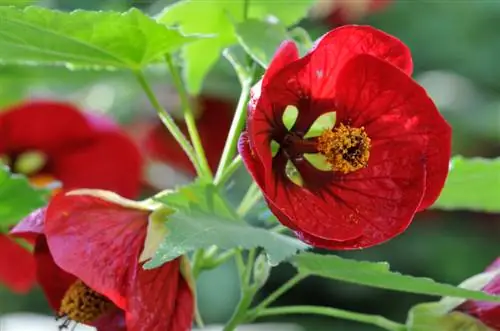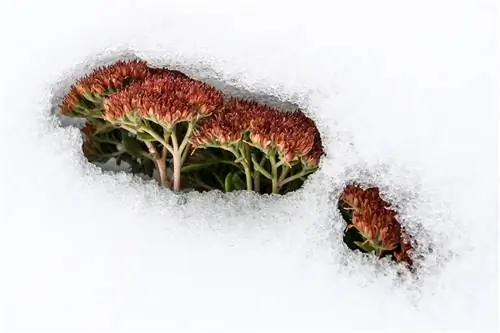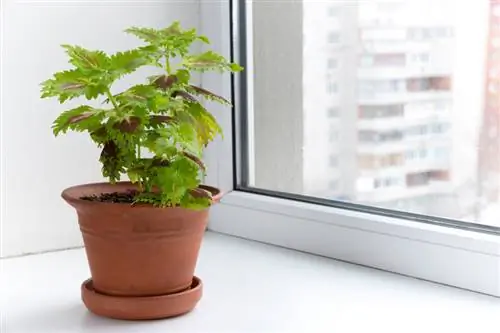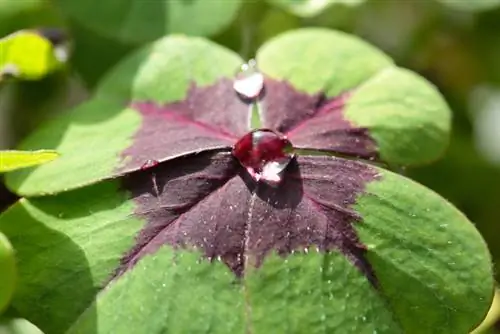- Author admin [email protected].
- Public 2023-12-24 12:37.
- Last modified 2025-06-01 06:02.
Pampas grass is not sensitive to cold, but reacts to too much moisture. For this reason, the pampas grass is tied or braided together for overwintering and protected with leaves and brushwood. This method prevents water from getting inside the perennial and thus protects against waterlogging.
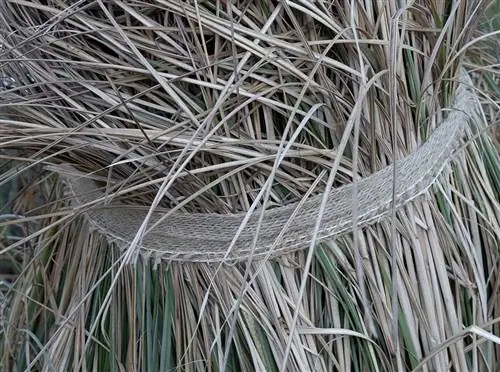
How should you properly overwinter pampas grass?
To overwinter pampas grass successfully, you should tie the stalks together before frost begins (usually in October or November) and protect the soil with leaves or brushwood. Potted plants also need an insulating base and possibly a jute sack covering. Cutting is not recommended in winter.
How is pampas grass overwintered?
Pampas grass is overwintered in a sunny and wind-protected location before the first long-lasting frost period (October at the earliest). In the open ground and in containers, the soil is protected with leaves and resig, and the stalks are tied together. This protects against cold and wet. The bucket should stand on a surface made of wood or Styrofoam.
Overwintering and winterizing pampas grass
The German name of the popular ornamental grass is derived from its homeland - the Pampas, a grassy landscape in southeastern South America. The climatic conditions there are different than in northern Europe. Above all, winter, which is cold and wet in Germany, but cold and dry in the Pampas. Pampas grass (Cortaderia selloana) can tolerate temperatures of up to -17 °C without any problems.
So that the plant feels completely at home in German gardens, the plant only needs to be protected against moisture. Inautumnthe pampas grass must thereforenot be cut. Instead, with just a few simple steps, the long stalks can be used to form a greenhead, which acts as an umbrella in winter. With this construction, dew and rain water flow down the sides - the sensitive heart inside the perennial is protected.
Overwintering in a bucket
Ideally, the pampas grass in the pot should be on asunny house wall with a canopy that protects against rain during the warm months. Then you can avoid tying it up in a forelock. However, the potted plant needs better thermal insulation before the first frost (around November) so that the root balls do not freeze. A wooden board, a Styrofoam plate or a bamboo mat as a base protect the pot from the cold of the ground.

We also recommend packing the entire bucket with a jute bag (€12.00 on Amazon). The durable jute bags are available in sizes S, M, XL or in lengths from 60 cm to 135 cm. Jute is a natural product and fits visually into winter gardens. As soon as the roots are no longer threatened by frost, the bucket can be freed from its winter coat. The multifunctional jute bag will definitely continue to be used until next winter.
Overwintering in the bed
Pruning in the fall is taboo! The pampas grass in the bed cannot be avoided by tying it up. Since the plant stays green throughout the winter in the milder regions of Germany, the tied grass is not only hardy, but also a refreshing eye-catcher.
Requires:
- Gloves (the edges of the leaves are very sharp!)
- stable band or rope (depending on size)
- Leaves and fir branches
- for particularly large grasses, perhaps a second person
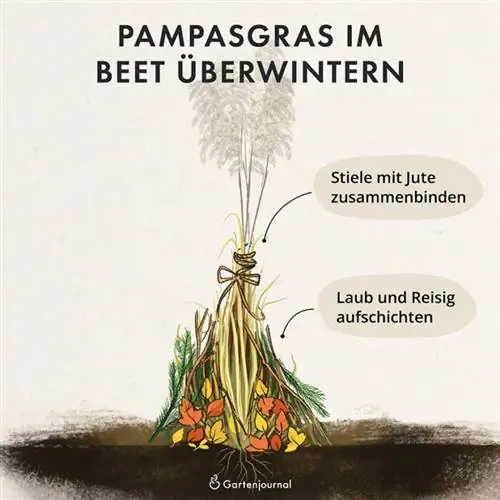
At the beginning you try to grab all the stalks like a braid of hair. Then, starting from the bottom, wrap all the leaves with a ribbon or rope and secure it with a loose knot. This step is repeated approximately three times with increasingly smaller distances from each other. The last knot should be located just below the flower, closing the structure like a teepee. Last but not least, leaves and pine branches are generously placed around the pampas grass.
Braiding pampas grass for overwintering
No more bad hair! If the green plants are too boring for you, you will probably like the artistic creations of some hobby gardeners. However, these woven garden sculptures require a lot more work. But it's definitely worth it: This is how pampas grass winters in style.
Check out this post on Instagram
A post shared by Della Mays (@dellamays3)
Pampas grass in autumn and winter
As summer comes to an end, the pampas grass stops growing. In most cases, all the stalks and flowers dry out over the winter, so that the previously green giant now appears straw-colored. But as long as the “heart” - the so-called eyrie - is protected inside, the grass comes to new life in spring. And no matter whether it is still green or dry: the foliage protects against moisture and must not be cut back in autumn.
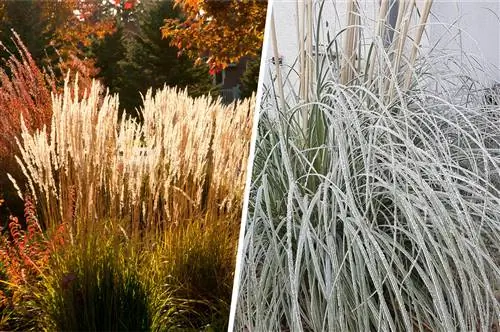
Pampas grass shows its flowers in autumn. In order to protect the plant from frost and condensation, among other things, pruning should only be done in spring.
When should you protect pampas grass?
It is best to take care of the pampas grass overwinteringbefore the first frost has set inIn Germany the thermometer reading dropsNovemberbelow the zero degree mark; sometimes already inOctober While other plants are cut, the pampas grass is tied together with the leaves upwards.
Do not cut pampas grass in winter
Pruning in winter or autumn can be fatal for the pampas grass. This means that the nest is exposed to the weather unprotected. Moisture gets into the gaps and the frost causes the perennial to crack like a road in winter. To ensure that the pampas grass survives the dark season and produces magnificent flowers again in summer, the grasses in the open field in particular must not be cut. Only when there is no longer any threat of frost in late spring can the dry stalks be cleaned out or cut.
FAQ
How to care for pampas grass in winter?
Pampas grass is tied together in a bunch so that the leaves act like a protective umbrella to keep moisture away from the frost-sensitive interior. Potted plants must be additionally insulated and continue to be watered in moderation. Fertilizer is not necessary.
Is pampas grass hardy?
Pampas grass is hardy and can withstand temperatures down to -17 °C. However, the popular ornamental grass does not cope well with the cold, humid climate. Therefore, the inside of the nest must be protected from moisture.
What does pampas grass look like in winter?
In milder regions of Germany, pampas grass retains its green color in winter. Most of the time, however, the grass that is cut back in late spring dries up.
How is pampas grass overwintered?
Pampas grass is tied together in tall bunches outdoors. Dew and rain water then flow down the sides, the sensitive heart inside remains dry. In the pot, a bright, covered location in combination with additional insulation of the pot is sufficient.
When is pampas grass winterized?
Pampas grass should be winterized before the first frost. In Germany, preparation begins from October to November, depending on the region.

